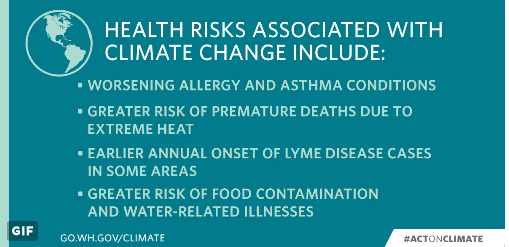The  Public Health Association of Australia is leading a range of discussions this week, particularly on Twitter, to mark #publichealthweek.
Public Health Association of Australia is leading a range of discussions this week, particularly on Twitter, to mark #publichealthweek.
Alas, it could only dream (particularly today with its focus on ecology and environment) of the Australian Government marking the awareness campaign, as the Obama administration did with the release of a new report, The Impacts of Climate Change on Human Health in the United States: A Scientific Assessment.
The White House says the report “significantly advances what we know about the impacts of climate change on public health, and the confidence with which we know it.”
See the Fact Sheet: What climate change means for your health and family. You can also watch the panel discussing its findings (three hours), involving the President’s Science Advisor, Dr. John P. Holdren, EPA Administrator Gina McCarthy, and Surgeon General Vivek Murthy.
The Guardian quoted Murthy as saying climate change represented a worse threat, in some respects, to public health than polio, as it could not be eradicated with a specific vaccine.

See also this report from the Sydney Morning Herald.
A few examples given of the increased health risks found in the assessment include:
-
Air pollution and airborne allergens will likely increase, worsening allergy and asthma conditions. Future ozone-related human health impacts attributable to climate change are projected to lead to hundreds to thousands of premature deaths, hospital admissions, and cases of acute respiratory illnesses each year in the United States by 2030, including increases in asthma episodes and other adverse respiratory effects in children. Ragweed pollen season is longer now in central North America, having increased by as much as 11 to 27 days between 1995 and 2011, which impacts some of the nearly 6.8 million children in the United States affected by asthma and susceptible to allergens due to their immature respiratory and immune systems.
-
Extreme heat can be expected to cause an increase in the number of premature deaths, from thousands to tens of thousands, each summer, which will outpace projected decreases in deaths from extreme cold. One model projected an increase, from a 1990 baseline for more than 200 American cities, of more than an additional 11,000 deaths during the summer in 2030 and more than an additional 27,000 deaths during the summer in 2100.
-
Warmer winter and spring temperatures are projected to lead to earlier annual onset of Lyme disease cases in the eastern United States and a generally northward expansion of ticks capable of carrying the bacteria that cause Lyme disease. Between 2001 and 2014, both the distribution and the number of reported cases of Lyme disease increased in the Northeast and Upper Midwest.
-
Increase the risks of water-related illnesses. Runoff from more frequent and intense extreme precipitation events, and increased water temperatures, will increasingly compromise recreational waters, shellfish harvesting waters, and sources of drinking water, increasing risks of waterborne illness.
-
Climate change, including rising temperatures and changes in weather extremes, is expected to increase the exposure of food to certain pathogens and toxins. Rising temperature and increases in flooding, runoff events, and drought will likely lead to increases in the occurrence and transport of pathogens in agricultural environments, which will increase the risk of food contamination and human exposure to pathogens and toxins. This will increase health risks and require greater vigilance in food safety practices and regulation.
-
Climate change will have the largest health impact on vulnerable populations including those with low incomes, some communities of color, limited English proficiency and immigrant groups, Indigenous peoples, children, pregnant women, older adults, vulnerable occupational groups, persons with disabilities, and persons with preexisting or chronic medical conditions.
-
Extreme weather and other events related to climate change will impact health by exacerbating underlying medical conditions, increasing exposure to foodborne and waterborne illness risks, and disrupting infrastructure, including power, water, transportation, and communication systems, that are essential to maintaining access to health care and emergency response services and safeguarding human health.
 The administration announced a series of new initiatives to “keep us on track to better understand, communicate, and reduce the health impacts of climate change on our communities”. They include
The administration announced a series of new initiatives to “keep us on track to better understand, communicate, and reduce the health impacts of climate change on our communities”. They include
- Expanding the scope of the President’s Task Force on Environmental Health Risks and Safety Risks to Children to focus on the impacts of climate change on children’s health.
- Developing K-12 educational materials on climate change and health.
- A Climate-Ready Tribes and Territories Initiative, which will provide awards for tribal and territorial health departments to investigate, prepare for, and adapt to the health effects of climate change.
- An update to the Sustainable and Climate Resilient Health Care Facilities Toolkit, issued by the Department of Health and Human Services.
- Designating May 23-27, 2016, as Extreme Heat Week, during which Federal agencies will take a number of actions to work with community planners and public-health officials to enhance community preparedness for extreme heat events.
Croakey will update this post with tweets from #publichealthweek.









